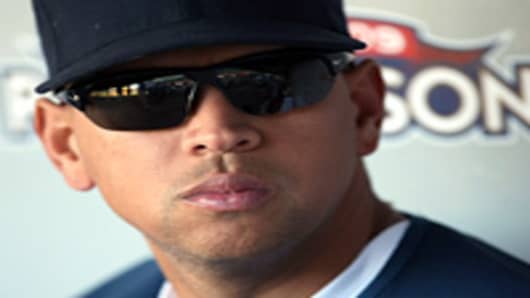The swollen ice wrap around Alex Rodriguez’s right knee looked like it might burst and spray popcorn around the room in all directions. He sat down and kept his leg erect, but couldn’t keep a straight face when someone asked if he physically felt 100 percent.
“A hundred percent?” he said, laughing. “No, I’m about 15 years from being 100 percent.”
Well, maybe give or take. It was only 13 years ago that Rodriguez posted career highs in at-bats (686) and stolen bases (46) and also had 213 hits as a sleek yet powerful young shortstop in Seattle. The 2011 model, coming off arthroscopic surgery last month for a torn meniscus, has the unmistakable look of an American League elder, a 36-year-old designated-hitter-in-waiting.
As a reminder of what appears to be a fast-approaching Jurassic period, or because seldom does the publicity machine known as A-Rod plan anything without broadcasting it on all available channels, he dropped a couple of foul flies Tuesday night in a six-inning rehab stint for the Scranton/Wilkes-Barre Yankees in a 2-0 loss to the Durham Bulls.
Under the minor league circumstances and the lights for the first time in weeks, it was all in good fun for Rodriguez—“a little entertainment value” for the fans at PNC Field, home of the Yankees’ AAA affiliate. The next stop, possibly as soon as Thursday in Minnesota pending another few swings on the farm Wednesday night, will be the big-boy clubhouse.
Once back, Rodriguez will reclaim third base, remember how to catch a pop-up and try to avoid finishing a season with fewer than 20 home runs (he currently has 13) for the first time since he became an everyday major leaguer.
“Hopefully I can come in and give them a shot in the arm and take it to the house the rest of the year,” he said, while noting that the Yankees haven’t exactly had to pray away a run-scoring (and victory) drought without him.
There is no more argument that Rodriguez’s days as the prototypical five-tool player and even the most feared bat in the Yankees lineup—not with Robinson Cano around—are over. Age and mileage and possibly the chemical spikes he admittedly added to his spinach have taken their toll.
Assuming his knee is fixed and he is able to drive the ball, Rodriguez can still do damage. He is only one season removed from 125 runs batted in. October is coming, and with the likes of Texas, Detroit and Boston in mind, the Yankees will be a more dangerous team with Rodriguez for the next two months.
How will they coexist?
Increasingly and alarmingly, the larger question looming is how will they manage to coexist for the next six years?
If you think Yankee Nation has been in deep distress and debate lately over the investment return from pitcher A. J. Burnett, imagine what awaits Rodriguez all the way through 2017 if his physical decline continues at the rate it has been going.
There was hip surgery in 2009, a visit to the disabled list last season for a calf injury and this year’s breakdown to go along with eye-opening drop-offs in power numbers. Is it a stretch to imagine a day when Rodriguez’s 10-year deal that could earn him more than $300 million — including bonus money for breaking the career home run record — will be considered the most ill-advised player contract in the history of the game?
Come to think of it, that very characterization might be the most fitting punctuation to an era bloated by illusion and greed.
Because of the headlines Rodriguez has generated, with more possibly to come, he will ultimately bear the brunt of the contract abuse. He, of course, didn’t give it to himself, no more than he made the former owner in Texas, Tom Hicks, hand him a $252 million deal a full decade ago.
Remember how the Goldman Sachs people acted as intermediaries between player and team after negotiations collapsed in 2007 and both sides announced they were moving on?
With the heavy hitters reaching out in his behalf, establishing another proud Wall Street legacy, Rodriguez called Hank Steinbrenner and had him at hello.
“Trust me, he would have gotten probably more,” Steinbrenner said in 2007, referring to a market that did not exist. “He is making a sacrifice to be a Yankee.”
Not long after, Steinbrenner was sent to his room by the family and replaced on public display by his more rational brother, Hal. Then came the steroid revelations that forever changed the A-Rod equation, and especially the economic value of his pursuit of Barry Bonds’s home run record.
Now, that achievement is no sure thing, though becoming the designated hitter — a wise move for Rodriguez and the Yankees, considering their lack of range on the left side of the infield — should help. But can Rodriguez hit 137 home runs before his body cries no más? Can he avoid more sordid revelations that might force baseball to suspend him?
In many ways, he remains the last vestige of the George Steinbrenner Yankees, a spectacle bought, overpaid for and impossible to ignore. On Tuesday night a horde of wide-eyed fans pressed their faces against the windows of the room as Rodriguez told reporters how much he was enjoying his visit to Moosic and how playing with the wannabe Yankees “kind of reconnects you to when I was back in the minor leagues, 18 years old.”
Oh, to be so young and innocent again.


